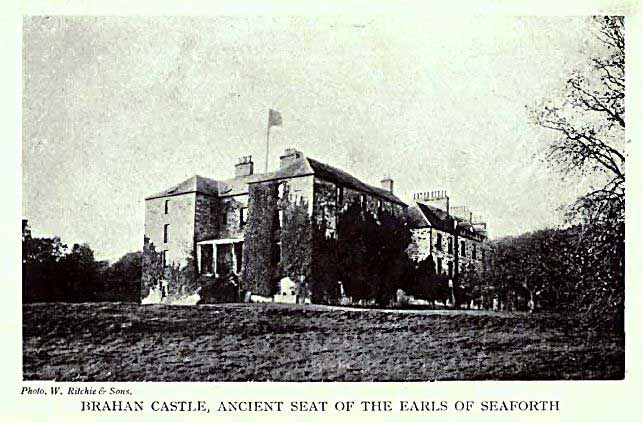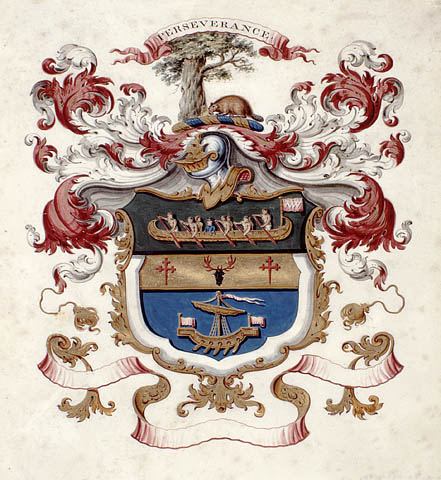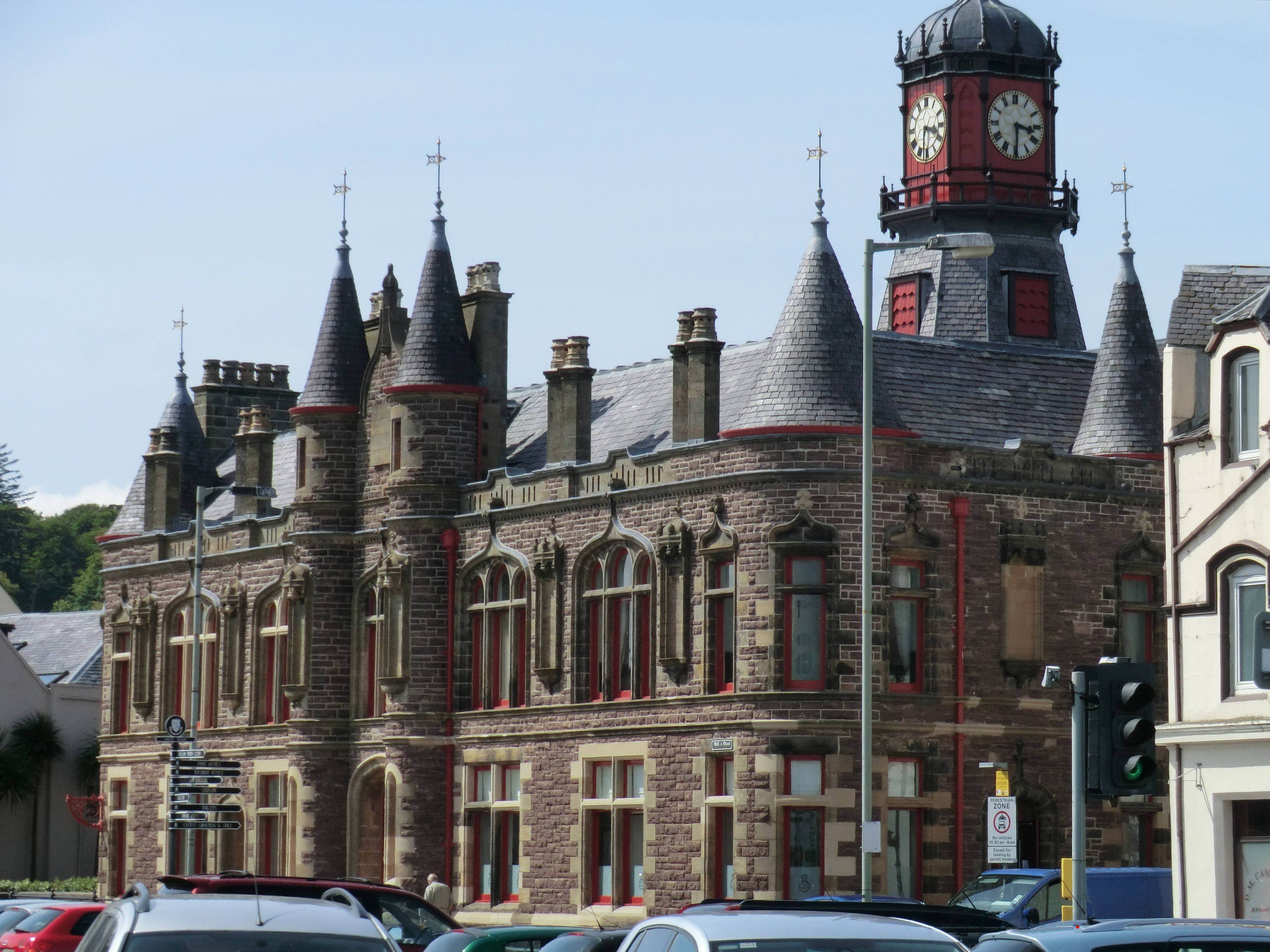|
Roderick Mackenzie Of Terrebonne
Lt.-Colonel The Hon. Roderick Mackenzie of Terrebonne (c.1761 − August 15, 1844) was a prominent Canadian fur trader, landowner and politician. He was a partner in the North West Company and a member of the Beaver Club at Montreal. He was a lifelong friend and the private confidant of his first cousin, Sir Alexander Mackenzie. He was an intellectual who established a library at Fort Chipewyan and both wrote and published works on the fur trade. In 1801 he made his home at Terrebonne, Quebec, purchasing the Seigneury in 1814, although he was forced by a court action to relinquish his title to the property in 1824. He continued to live there until his death. He held many public appointments, most notably as a member of the Legislative Council of Lower Canada. Early life Roderick Mackenzie was born in the Scottish Highlands at Achiltibuie in about 1761. He was the second son of Alexander Mackenzie (1737−1789) of Achnaclerach, who was killed after falling from his horse following a ... [...More Info...] [...Related Items...] OR: [Wikipedia] [Google] [Baidu] |
The Honourable
''The Honourable'' (British English) or ''The Honorable'' (American English; see spelling differences) (abbreviation: ''Hon.'', ''Hon'ble'', or variations) is an honorific style that is used as a prefix before the names or titles of certain people, usually with official governmental or diplomatic positions. Use by governments International diplomacy In international diplomatic relations, representatives of foreign states are often styled as ''The Honourable''. Deputy chiefs of mission, , consuls-general and consuls are always given the style. All heads of consular posts, whether they are honorary or career postholders, are accorded the style according to the State Department of the United States. However, the style ''Excellency'' instead of ''The Honourable'' is used for ambassadors and high commissioners. Africa The Congo In the Democratic Republic of the Congo, the prefix 'Honourable' or 'Hon.' is used for members of both chambers of the Parliament of the Democratic Repu ... [...More Info...] [...Related Items...] OR: [Wikipedia] [Google] [Baidu] |
Brahan Castle
Brahan Castle was situated south-west of Dingwall, in Easter Ross, Highland Scotland. The castle belonged to the Earls of Seaforth, chiefs of the Clan Mackenzie, who dominated the area. History Brahan Castle was built by Colin Mackenzie, 1st Earl of Seaforth in 1611. Kenneth Mackenzie, a labourer on the estate, was a reputed seer who made a number of prophecies in the later 17th century. He is remembered as the Brahan Seer. The Mackenzies were prominent Jacobites, and took part in the Jacobite risings of 1715, 1719 and 1745. The Siege of Brahan took place in November 1715. William Mackenzie, 5th Earl of Seaforth, was attainted, forfeiting the estate, which in 1725 became the headquarters of General Wade during his "pacification" of the Highlands. After the later Jacobite rising of 1745, the Mackenzies were the first clan to surrender, being forced to swear allegiance to the British Crown on the steps of the castle. The estate was later sold back to the Mackenzie family, althou ... [...More Info...] [...Related Items...] OR: [Wikipedia] [Google] [Baidu] |
Joseph Frobisher
The Hon. Joseph Frobisher (April 15, 1748 – September 12, 1810) M.P., J.P., was one of Montreal's most important fur traders. He was elected to the 1st Parliament of Lower Canada and was a seigneur with estates totalling 57,000 acres. He was a founding member of the North West Company and the Beaver Club, of which he was chairman. From 1792, his country seat, Beaver Hall, became a centre of Montreal society. Early life Joseph Frobisher was born at Halifax, Yorkshire in 1748. He was the third of five sons born to Joseph Frobisher (1710–1763) and Rachel Hargreaves (1718–1790). The Frobishers were an old Yorkshire family descended from Richard Frobysher of Altofts and Thorne, a first cousin of Sir Martin Frobisher. Joseph's eldest two brothers, Benjamin and Thomas (1744-1788), came to Quebec soon after the British Conquest of New France to enter the fur trade, and Joseph joined them in 1769. They put to use the small capital they had between them to set up a fur ... [...More Info...] [...Related Items...] OR: [Wikipedia] [Google] [Baidu] |
District Of Athabasca
The District of Athabasca was a regional administrative district of Canada's Northwest Territories. It was formed in 1882, was later enlarged, and then abolished with the creation of the provinces of Saskatchewan (its central-eastern part) and Alberta (western part) in 1905. The very easternmost part is now within Manitoba. Boundaries Its northern boundary was the current southern boundary of the Northwest Territories and the western part met the boundary of British Columbia. In 1882 it included most of the northern portion of the modern-day Province of Alberta. On the south, its boundary with the District of Alberta was the 18th correction line, approximately 55° north, now designated Township Road 710."Canadian North West", Prince Albert Times, Dec. 13, 1882 In 1895 it was expanded east to include the northern portion of the modern-day Province of Saskatchewan and part of northwestern modern-day Manitoba, and the southern boundary was moved northward. See also *Territorial ... [...More Info...] [...Related Items...] OR: [Wikipedia] [Google] [Baidu] |
Simon McTavish (fur Trader)
Simon McTavish (1750 – 6 July 1804), of Montreal was a Scottish-born fur trader and the chief founding partner of the North West Company. He was a member of the Beaver Club and was known as the ''Marquis'' for his pre-eminent position in the fur trade and his refined style of living. Both McTavish Street and the McTavish Reservoir in Montreal are named for him. His home and monument in the Golden Square Mile were longstanding landmarks in Montreal. Renowned for his generosity, when the Chief of the Clan MacTavish had fallen on hard times and was forced to sell their seat, Dunardry, McTavish bought it back for the clan and gave his eldest son employment in Montreal. Highlands Background In 1751, Simon McTavish was born at Stratherrick in the Scottish Highlands, the son of John McTavish (1701–1774), tacksman of Garthbeg, who bore the arms of the McTavishes of Garthbeg. His mother, Mary Fraser (1716–1770) of Garthmore, was descended through Simon Fraser of Dunch ... [...More Info...] [...Related Items...] OR: [Wikipedia] [Google] [Baidu] |
Pinehouse Lake
Pinehouse Lake is a lake in northern Saskatchewan, Canada. The northern village of Pinehouse is located on the western shore. The Churchill River flows in from Sandy Lake into the north-west end of the lake at McDonald Bay and flows out through the north-east end of the lake into Sandfly Lake. See also *List of lakes of Saskatchewan This is a list of lakes of Saskatchewan, a province of Canada. The largest and most notable lakes are listed at the start, followed by an alphabetical listing of other lakes of the province. Larger lake statistics "The total area of a lak ... References Statistics Canada Lakes of Saskatchewan {{Saskatchewan-geo-stub ... [...More Info...] [...Related Items...] OR: [Wikipedia] [Google] [Baidu] |
Archibald Norman McLeod
Major The Hon. Archibald Norman McLeod (17 March 1772 – after 1837) J.P., was a partner of the North West Company and a political figure in Lower Canada. In 1805, he built Fort Dunvegan. He was a member of the Beaver Club and represented Montreal West in the Legislative Assembly of Lower Canada from 1810 to 1814. He fought in the War of 1812 as a Major with the Corps of Canadian Voyageurs and the Canadian Voltigeurs. McLeod Lake, British Columbia is named for him. Born at Kilfinichen, he was the fifth son of Rev. Neil McLeod (1729-1780) M.A., a native of St Kilda, and Margaret MacLean (1737-1789), daughter of Rev. Archibald MacLean (b.1683) M.A., of the MacLeans of Boreray, North Uist. Archibald's grandfather, John McLeod (1696-1792), 4th Laird of Pabbay and Steward of St Kilda, was directly descended from the 6th Chief of Clan MacLeod of Lewis, of Dunvegan Castle. In 1773, Samuel Johnson and James Boswell stayed as guests of Archibald's father, who Boswell described as ... [...More Info...] [...Related Items...] OR: [Wikipedia] [Google] [Baidu] |
Quebec
Quebec ( ; )According to the Canadian government, ''Québec'' (with the acute accent) is the official name in Canadian French and ''Quebec'' (without the accent) is the province's official name in Canadian English is one of the thirteen provinces and territories of Canada. It is the largest province by area and the second-largest by population. Much of the population lives in urban areas along the St. Lawrence River, between the most populous city, Montreal, and the provincial capital, Quebec City. Quebec is the home of the Québécois nation. Located in Central Canada, the province shares land borders with Ontario to the west, Newfoundland and Labrador to the northeast, New Brunswick to the southeast, and a coastal border with Nunavut; in the south it borders Maine, New Hampshire, Vermont, and New York in the United States. Between 1534 and 1763, Quebec was called ''Canada'' and was the most developed colony in New France. Following the Seven Years' War, Quebec b ... [...More Info...] [...Related Items...] OR: [Wikipedia] [Google] [Baidu] |
Colin Mackenzie
Colonel Colin Mackenzie CB (1754–8 May 1821) was Scottish army officer in the British East India Company who later became the first Surveyor General of India. He was a collector of antiquities and an orientalist. He surveyed southern India, making use of local interpreters and scholars to study religion, oral histories, inscriptions and other evidence, initially out of personal interest, and later as a surveyor. He was ordered to survey the Mysore region shortly after the British victory over Tipu Sultan in 1799 and produced the first maps of the region along with illustrations of the landscape and notes on archaeological landmarks. His collections consisting of thousands of manuscripts, inscriptions, translations, coins and paintings, which were acquired after his death by the India Office Library and are an important source for the study of Indian history. He was awarded a Companion of the Order of the Bath on 4 June 1815. Early life Colin Mackenzie was born in Storno ... [...More Info...] [...Related Items...] OR: [Wikipedia] [Google] [Baidu] |
Tacksman
A tacksman ( gd, Fear-Taic, meaning "supporting man"; most common Scots spelling: ''takisman'') was a landholder of intermediate legal and social status in Scottish Highland society. Tenant and landlord Although a tacksman generally paid a yearly rent for the land let to him (his "tack"), his tenure might last for several generations. He would often be related to his landlord and might, for example, represent a cadet branch of the family of the clan chief. The tacksman in turn would let out his land to sub-tenants, but he might keep some in hand himself. Dr Johnson defined the class in this manner: The three fundamental obligations traditionally imposed on tacksmen were grassum (a premium payable on entering into a lease), rental (either in kind, or in money, which was designated "tack-duty"), and the rendering of military service.Alexander Nicholson, ''History of Skye'' (3rd edition, Islands Book Trust, 2012), at pages 127 to 128. Inheritance As described by James Mitchell: ... [...More Info...] [...Related Items...] OR: [Wikipedia] [Google] [Baidu] |
Stornoway
Stornoway (; gd, Steòrnabhagh; sco, Stornowa) is the main town of the Western Isles and the capital of Lewis and Harris in Scotland. The town's population is around 6,953, making it by far the largest town in the Outer Hebrides, as well as the third largest island town in Scotland after Kirkwall in Orkney and Lerwick in Shetland. The traditional civil parish of Stornoway, which includes various nearby villages, has a combined population of just over 10,000. The Comhairle nan Eilean Siar measures population in a different area: the ''Stornoway settlement'' area, Laxdale, Sandwick and Newmarket; in 2019, the estimated population for this area was 6,953. Stornoway is an important port and the major town and administrative centre of the Outer Hebrides. It is home to ''Comhairle nan Eilean Siar'' (the Western Isles Council) and a variety of educational, sporting and media establishments. Until relatively recently, observance of the Christian Sabbath (Sunday) has been associate ... [...More Info...] [...Related Items...] OR: [Wikipedia] [Google] [Baidu] |
Laird
Laird () is the owner of a large, long-established Scottish estate. In the traditional Scottish order of precedence, a laird ranked below a baron and above a gentleman. This rank was held only by those lairds holding official recognition in a territorial designation by the Lord Lyon King of Arms. They are usually styled 'name'' 'surname''of 'lairdship'' However, since "laird" is a courtesy title, it has no formal status in law. Historically, the term bonnet laird was applied to rural, petty landowners, as they wore a bonnet like the non-landowning classes. Bonnet lairds filled a position in society below lairds and above husbandmen (farmers), similar to the yeomen of England. An Internet fad is the selling of tiny souvenir plots of Scottish land and a claim of a "laird" title to go along with it, but the Lord Lyon has decreed these meaningless for several reasons. Etymology ''Laird'' (earlier ''lard'') is the now-standard Scots pronunciation (and spelling, which is ph ... [...More Info...] [...Related Items...] OR: [Wikipedia] [Google] [Baidu] |



.jpg)


